|
Profile Status Update, late 2022. Original Profile
Submitted to the Hōgaku Journal Nov. 2022 Issue #430 editor, in mid-2022.

Torsten Olafsson featured in Hōgaku Journal, November 1, p. 39, 2022
Link to the actual printed profile, Nov., 2022:
Torsten Olafsson Profile Featured in the Music Magazine
Hōgaku Journal Vol. 430, Nov., 2022
The BACKGROUND:
In Summer, 2022, on behalf of Hōgaku Journal editor Tanaka Takafumi, ethnomusicologist
PhD Kiku Day invited me to produce a presentation of myself for a profile to be printed
in a forthcoming issue of the esteemed music magazine that covers most if not all aspects of traditional Japanese music.
I was prompted to also tell at length about my research findings, but it turned out that the slot space in the journal was much more limited than expected:
Reduced to but half a page, or so.
For you to know what I actually delivered to the Hōgaku Journal, here you have the complete,
unabridged and unredacted text in English.
That is, except for a few translations to English of specially selected Japanese quotations
meant to be shown in Japanese, only, in the magazine.
All the best, Torsten Olafsson, January, 2023.
TORSTEN ‘Mukuteki’ OLAFSSON
A Presentation for the Hōgaku Journal Vol. 430, November issue, 2022
Torsten ’Mukuteki’ Olafsson is a Danish-Icelandic multi-musician, composer, music editor & engraver, graphics designer, shakuhachi player, Japanologist and shakuhachi historian.
Born on January 28th, 1950, Torsten grew up on the island Amager in S. Copenhagen in a musically and linguistically gifted and inspiring family.
Both his parents were medical doctors and general physicians.
Since early 2000, he has been living in Elsinore north of Denmark’s capital, the town of Kronborg Castle, a UNESCO World Heritage Site, and Shakespeare’s 1603 play “Hamlet”.
After years of childhood piano lessons, and lots of singing, it felt natural to specialize in music high school during the mid- to late 1960s.
At the same time - already having also played the drums for some years - Torsten took up the electric bass guitar and, in 1968, formed the internationally reputed
symphonic progressive rock band ACHE, together with his younger brother Finn Olafsson on guitars, and their two local musician friends:
Glenn Fischer, drums, and Peter Mellin, Hammond organ.

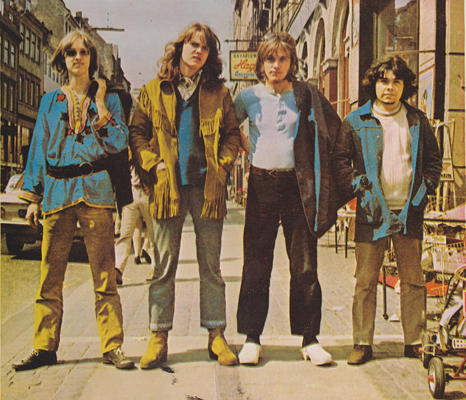
Torsten Olafsson - Legendary symphonic prog rock band ACHE, 1970
In 1969, the band created the music for the world’s very first true beat/rock ballet, choreographed by Royal Danish solo dancer Peter Schaufuss,
released on LP by PHILIPS in 1970.
ACHE’s two first albums have been re-issued many times since then, also outside Denmark, latest in Japan on two re-mastered Belle Antique label CDs, in early 2020.
In 1968, simultaneously with developing ACHE, Torsten enrolled as a student of Chinese Culture, Philosophy, Art & Music at the University of Copenhagen.
One day, in 1970, a ballerina friend presented him with the Yamaguchi Gorō LP “A Bell Ringing in the Empty Sky”, Nonesuch H-72025, that had recently been released in USA -
although rather as some kind of exotic New Age Music there.
A few years later, two Copenhagen concerts featuring Yokoyama Katsuya and his father, Yokoyama Ranpo, also made further strong impressions.
Torsten had soon become fascinated with that extraordinary flute “music” that appeared to have arisen from non-dualistic ideologies such as Indian Advaita, Chinese Taoism, and Japanese Zen.
So, in 1974, he changed his focus to the academic study of the Japanese language: classical, kanbun and modern, and he soon applied and eventually qualified
for a Rotary Foundation Graduate Student Scholarship in order to go to Kyōto to study Japanese art, aesthetics and music.
Landing in early 1977, Torsten was warmly welcomed by the Rotary Foundation Tamura host family of Ōharada-chō in Ichijō-ji, Sakyō-ku, Kyōto.
Even today there is frequent hearty contact between the Tamura family and Torsten, their late 1970s’ Danish guest student.
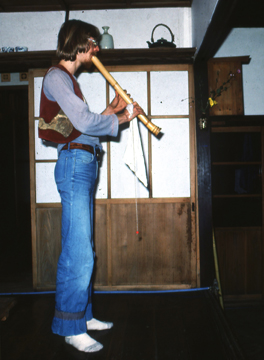
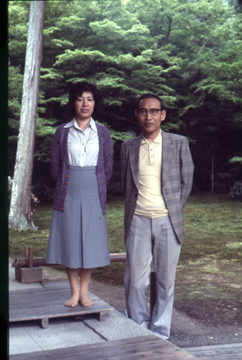
Torsten in Ichijō-ji, Kyōto, 1977 - Tamura Yoshiko & Tamura Shōzō in NE Kyōto, 1977
In summer, 1977, Torsten was kindly introduced to the 40th Kyōto Myōan-ji Kansu, Yoshimura Fuan Sōshin, 1904-1998, when he was staying south of Kyōto,
temporarily teaching Taizan-ha shakuhachi there.
Hearing that sound of truly authentic Taizan-ha ‘Suizen’ Shakuhachi for the first time ever, Torsten felt deeply impressed and moved:
So much more basically “ascetic” than Kinko-ryū shakuhachi, indeed!
Do note that, at that time, “orthodox” solo shakuhachi styles like Myōan Shakuhachi were still being looked down upon in the West ...
After the visit, Torsten wrote a letter to Yoshimura Sensei in Japanese, enclosed with a copy of ACHE’s first two albums, re-issued by PHILIPS on music cassette in 1976,
as kind of an introduction, while asking to become a student.
Soon afterwards, Yoshimura Sensei kindly replied in writing and then prompted his own former Taizan-ha student, Ozawa Seizan, 1939-2012, in Yamashina, now a licensed teacher,
to be Torsten’s Myōan Shakuhachi teacher.
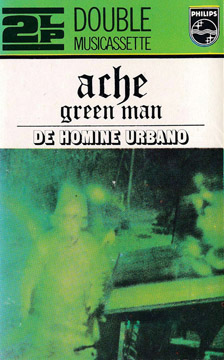

ACHE double MC Philips, 1976 - Yoshimura Fuan Sōshin 'Suizen ichinyo' CD set, 1995
As a special gesture, Yoshimura Sensei also sent two music cassettes that contained copies of his recordings of almost all of the genuine Taizan-ha ‘Suizen’ honkyoku
that had first been released on four LPs - probably in the mid-1970s? - and were later, in 1995, published by the Myōan Temple on the triple-CD set titled ‘Suizen ichinyo’,
“The Non-Duality of Ascetic Shakuhachi”, by Yoshimura Fuan Sōshin.
That unique honkyoku anthology absolutely ought to be re-released by the Myōan Temple, world-wide - the sooner the better.
Time went by – back in Denmark again, in early 1983, having then completed extended B.A. degrees in both Chinese Culture and Japanology,
Torsten was employed as an academic consultant by the National Museum of Denmark for the magnificent summer exhibition “Japan i Brede”.
Given that opportunity, already a well experienced studio musician, Torsten made up his mind to record the solo shakuhachi album “Standing Waves – Zen Shakuhachi Meditations”
which was released on both LP and MC as the very first phonogram by the new record company Olafssongs, managed by Torsten’s brother Finn and co-managed by himself.
“Standing Waves” is quite probably the first shakuhachi record to have been produced in Europe, by a European.
The soundtrack was used throughout the National Museum’s summer exhibition period in Brede as specially selected background music.
In 1984, Geoff Duckworth commented on “Standing Waves” in the then International Shakuhachi Society journal Take no Michi, England:
“You may, or may not like the music on this record. But I think this would miss the point, that this record adds to the richness of both one's personal store,
and the whole body of shakuhachi music.”
In that same year, 1983, an extremely important book landed in Olafsson’s post box:
Nakatsuka Chikuzen’s ‘Kinko-ryū shakuhachi shikan’, Nihon Ongaku-sha, 1979.
Going through, dating and registering the entire impressive contents of historical source materials, researching a substantial subject for an appropriate master’s thesis in Japanology,
there in that book Olafsson also discovered a reprint of the 1628 document ‘Kaidō honsoku’, often alternatively titled f.i. ‘Boro komosō honsoku’,
or ‘Boro no techō’, and others.
That unique ‘komosō’ text scroll was actually reported missing – or rather: In fact stolen? - from the Kōkoku Temple in Yura already in the early 1980s, or so.
And only a very few Japanese historians and Western shakuhachi students have ever mentioned that document at all but quite superficially, at the very best.
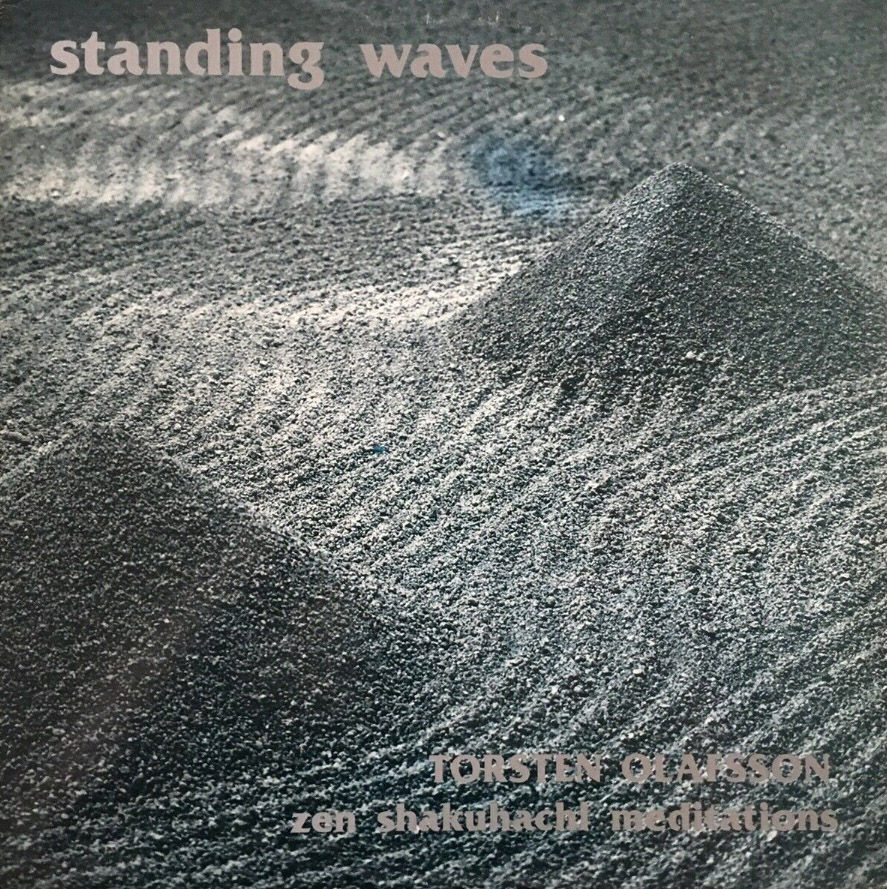
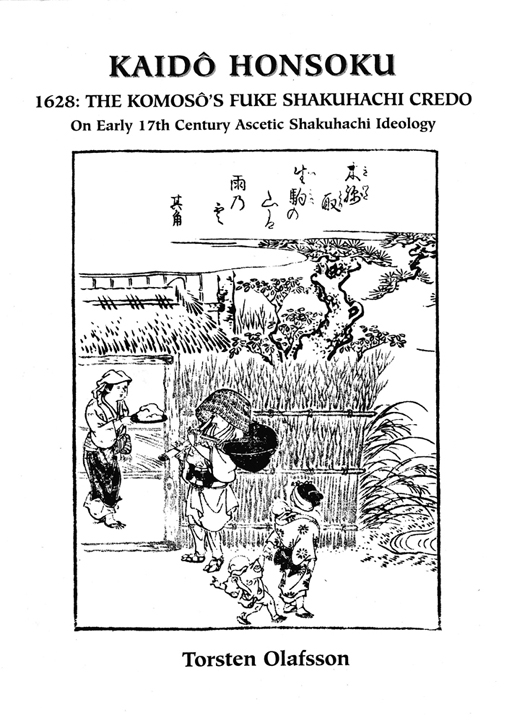
Standing Waves LP, 1983 - 'Kaidō honsoku', 1628, thesis introduction, 1987/2003
Olafsson’s thesis, titled
“Kaidō honsoku. The Komosō’s Fuke Shakuhachi Credo. On Early 17th Century Ascetic Shakuhachi Ideology”,
was submitted to the University of Copenhagen in mid-1987, presenting a complete translation and a comprehensive commentary in English with numerous illustrations.
Practically completely ignored and forgotten for many years, however, in 2003, Olafsson’s ‘Kaidō honsoku’ thesis appeared in public, now supplemented with an additional,
expanded introduction, published internationally by North California-based Monty H. Levenson and his widely respected publishing firm, Tai Hei Shakuhachi.
Dan E. Mayers, then president of the International Shakuhachi Society, praised Olafsson’s research and the thesis, and also published the new introduction in the society’s
Annals Vol. 2, in 2005.
Then, in 2008, the late Ōsaka University Prof. Tsukitani Tsuneko, d. 2010, concluded in her article in the book “The Ashgate Research Companion to Japanese Music”,
published by Routledge. Taylor & Francis Group, on page 168:
"The body of shakuhachi researchers in Japan is relatively small; names that recur in the bibliography include Kamisangō, Tsukitani/Tukitani, Seyama and Simura/Shimura.
It is regrettable that the most conspicuous work is being produced not in Japan but by scholars abroad. (See the works by Fritsch, Gutzwiller, Keister, Lee, Olafsson.)"
With the publication of the ‘Kaidō honsoku’ testimony in 2003, at the time when the WWW Internet was “exploding”, so to speak, and quickly expanding in both scope and detail,
Torsten took up the challenge and soon began to share his shakuhachi history and ideology research findings and conclusions on a website of his own,
at first c/o his personal homepage named torstenolafsson.dk.
As the number of web pages and subjects kept still growing, a separate website proved to be necessary, so the “Zen Shakuhachi, Denmark” homepage became a reality.
The site can be reached via this internet portal: www.torstenolafsson.dk for anyone curious.
The website’s official title is:
「修行尺八 歴史的証拠の研究 ホームページ」
The "Ascetic Shakuhachi" Historical Evidence Research Web Pages. Introduction & Guide to the Documentation & Critical Study of Ascetic, Non-Dualistic Shakuhachi Culture, East &
West: Historical Chronology, Philology, Etymology, Vocabulary, Terminology, Concepts, Ideology, Iconology & Practices
Over the last 10 to 15 years, source materials illuminating shakuhachi history and ideology in more and more detail have been shared on the internet in still increasing quantity and quality.
The historical evidence is now there for all to see and appreciate.
Still, myths, romantic narratives, wishful thoughts - even obvious untruths - about the shakuhachi, have been spreading rapidly – especially, and not least in the West:
On various WikiPedia sites and web pages, and on numerous personal shakuhachi homepages.
Despite several dozens of shakuhachi “history” writers claiming so, on print and online - even so academically trained ethnomusicologists who really do not know how to read
and interprete any classical Japanese or Chinese texts, including kanbun - there does not exist any trustworthy written nor pictorial evidence, whatsoever,
that Edo Period ‘komusō’ ever practiced any kind of “shakuhachi meditation” – or: “shakuhachi zen”.
No one has ever presented such “proof”.
That is merely a modern invention of the post-World War II era.
Torsten Olafsson’s research has revealed, irrefutably, that the now very popular concept ‘Suizen’ was invented within the circles of the Kyōto Myōan-ji only after,
never before 1950 exactly, quite possibly by that revived temple’s first ever genuine “Fuke Temple Zen head monk”, Yasuda Tenzan, 1909-1994.
Furthermore, Torsten Olafsson also discovered a letter from the Rinzai Zen abbot Isshi Bunshu, 1608-1646, to the komusō Sandō Mugetsu, n.d., dating from the early 1640s.
He based his English translation of the text on an actual physical, direct xerox copy of the document supplied to him personally by the Kōkoku Temple in early 1985.
Isshi Bunshu appears to be the very first person ever who presented the new term ‘komusō’ in writing. No other shakuhachi historian but Olafsson
has ever translated and described that unique ascetic shakuhachi source, so far.
Additionally, Olafsson has clarified how the harsh government persecutions of Christian converts during the early decades of the 17th century, ca. 1630-1650,
inevitably lead to the late Komosō Brotherhood transforming into a fake komusō “Buddhist sect”, that later came to be known as the ‘Fuke-shū’,
which in fact had only weak “affiliations with Rinzai Zen”,
if any.
Torsten Olafsson learned the essence of Taizan-ha Shakuhachi and ‘Suizen’ before that tradition and that term became much more widely known, be that even respected,
neither in the East, nor in the West.
He has described, online, how the whole origin, history and “essence” of Myōan Taizan-ha ‘Suizen’ became forever ignored and obscured when, in 1974,
the record company Nippon Columbia released a triple-LP shakuhachi set titled ‘Suizen’, with an accompanying text claiming that ‘Suizen’ had been known and practiced in Japan
for many centuries – without presenting the slightest textual, documentary evidence for that claim.
Olafsson has never been practicing as a “shakuhachi teacher” as such, being convinced that an experienced, native Japanese teacher is best qualified
to transmit all the delicate secrets properly – to any shakuhachi student. Nor has he given “concerts”, as mere entertainment.
He has, however occasionally, been invited to give lectures about shakuhachi history, ideology and music while also playing examples on the shakuhachi.
When Danish museums have arranged exhibitions about Japan, every now and then, Torsten has been requested to play a little shakuhachi at the opening receptions.
That was the case, for example, when in 2017, on June 16, the special exhibition “Japan i Kongehuset”, “Japan in the Danish Royal House”,
opened in Christian VIII’s Palace at Amalienborg in Central Copenhagen.
With the two exhibition protectors, His Imperial Highness Crown Prince Naruhito of Japan and His Royal Highness Prince Frederik of Denmark, seated as the guests of honour,
Torsten played three short honkyoku from the Myōan Tazan-ha ‘Suizen’ shakuhachi repertory – on the invitation of the exhibition organizers.
.
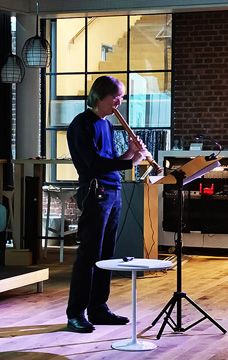

Left: Torsten Olafsson at the Elsinore "Culture Yard" Center, 2019
Right: Myōan 1.8 shakuhachi made by Ozawa Seizan
From the onset in his research, more than 45 years ago, it was Torsten Olafsson’s primary intention to find, interpret and translate essential literary statements
about ascetic shakuhachi ideology and practice.
He still investigates and analyzes texts of special interest.
It is unique with the shakuhachi that there is ‘Gakki no shakuhachi’, or ‘Kanshō no shakuhachi’ on the one hand ... and, there is ‘Shugyō no shakuhachi’,
or just ‘Gyō no ongaku’, the latter in the words of Uramoto Setchō, 1891-1965.
Two hundred years ago, way before Kinko-ryū Shakuhachi practice, eventually, transformed into a performing professional musician’s ‘Gikō no shakuhachi’ style,
Hisamatsu Fūyō, 1791-1871 – who may in fact never have been a komusō? – stated the following:
「初心より美敷(うつくしき)音のむまみ(旨味)
を修行すべからず。
音艶むまみは出来るを好んで出かすを嫌ふ。」
In English:
"From the beginning [basically], do not [ascetically] practice the "tastefulness of a beautiful sound".
I do not like it when people are pleasing themselves with producing charming, tasteful sounds."
Trsl. by T.O.
Echoing the mythical Zen hermit Fuke’s ‘Myō-An’ poem which expresses a clever critique of Dualism and Dualistic Thinking, in the dance kyōgen play ‘Rakuami’,
15th century, you learn:
「両頭を切断してより
尺八寸の内古今に通ず。
吹き起こす無常の一曲
三千里外に知音を絶つ
作くられたり。」
In English:
"When Dualism is cut off [or, eliminated, rejected],
the inside of the shakuhachi transcends
[the distinction between] Past and Present.
That unique Sound of Impermanence blowing forth
brings even the Purest of Wisdom [Skt.: Jnana] to an end,
without limit."
Trsl. by T.O.


Left: 'Mukuteki suizen' calligraphy by Hirazumi Taizan
Right: Ozawa Seizan, Kyōto, 1978 - Photos by T.O.
Epilogue:
In Spring, 1978, in a letter of recommendation to Torsten Olafsson, Ozawa Seizan expressed
as follows:
「当明暗尺八は、普化宗に属じ日本古耒の伝承されじ尺八お法器として、
明暗双々円通無碍の実力を修得じ、虚に帰して、精神の修養を高めんとするしので有る。 これを吹禅と稱する。」
In English:
"Myōan Shakuhachi is related to the Fuke Sect of Shakuhachi and it has as its purpose to employ the ancient Japanese shakuhachi flute as a Dharma instrument [hō-ki]
in order that one understands the Ultimately Adual Nature of the 'Bright' and the 'Dark' [Myō-An] and experiences the Essence of Non-substantiality [kyo] through Self-Cultivation.
This [practice] is called 'Suizen'."
Trsl. by T.O.
These are the words in a fine calligraphy written by the second head monk of the new Myōan Temple, Hirazumi Taizan, in service 1953-1984,
that Ozawa Seizan presented as a gift to Torsten in Spring, 1978:
「無孔笛 吹禅」 むくてき すいぜん
“Flute of No Holes – Suizen”
By Torsten Olafsson, Autumn, 2022
|
|













